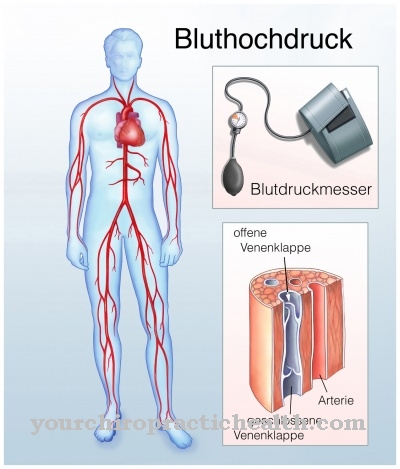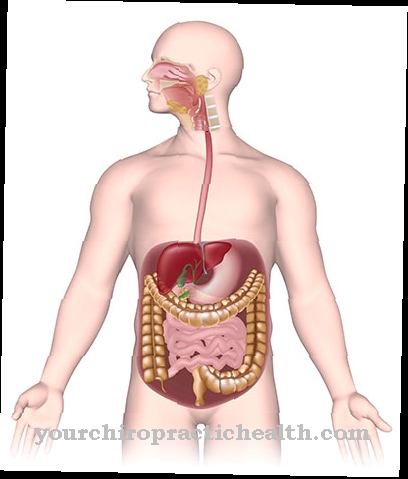The inability to empty one's own bladder is also called in medicine Urinary obstruction or. Urinary obstruction designated. Depending on the symptoms, a distinction is made between acute urinary congestion and chronic urinary congestion.
What is urinary obstruction?

If there is an obstruction in the urinary tract, the urine of the person concerned can no longer flow freely. The obstacles usually occur in the area of the kidneys or in the area of the ureters. Depending on the severity, an obstacle can also arise in the area of the urinary bladder or in the area of the tap tube.
If left untreated, urinary congestion can be life-threatening for those affected. For example, the passage of bacteria from the urogenital tract into the bloodstream leads to life-threatening blood poisoning.
Depending on the severity, chronic kidney failure can also occur in addition to so-called urosepsis. The affected person must always undergo dialysis in the context of chronic kidney failure. In order to determine an optimal therapy, however, the causes of urinary congestion must first be determined.
causes
Stones in the ureters and kidneys can be the cause of urinary congestion. Not infrequently, however, tumors also promote the occurrence of urinary congestion.
If, for example, the body is exposed to high levels of violence in the course of an accident, a so-called trauma can lead to acute urinary congestion.
Often those affected can no longer actively control their urine flow due to an underlying neurological disease. For example, in the case of paraplegia, it is necessary to insert a urinary catheter. Chronic urinary congestion is primarily promoted by congenital narrowing of the urethra.
You can find your medication here
➔ Medicines for bladder and urinary tract healthSymptoms, ailments & signs
Urinary congestion can appear suddenly or gradually. It is associated with severe pain and pressure in the lower abdomen. The bulging bladder can no longer empty and overflows. Therefore, in addition to the pain, the patient complains of constant urination. This leakage of urine cannot be suppressed and is therefore known as overflow incontinence.
Flank pain is unbearable in acute urinary obstruction. It is colic-like pain that sometimes radiates to the groin or genitals. Sometimes there is blood in the urine. In some cases you may experience chills and fever. This is a particularly life-threatening emergency because it could be something called urosepsis.
Complete urinary retention is also rarely observed, in which even overflow incontinence is eliminated. The urine then builds up in the renal pelvis and ureters and leads to long-term kidney damage. However, acute urinary congestion can heal without any consequential damage if treatment is initiated in good time. Chronic urinary congestion leads to consequential damage, which is particularly noticeable in renal insufficiency and even kidney failure.
The chronic urinary congestion can remain completely symptom-free. In some cases, however, flank pain, nausea and vomiting also occur here. If kidney damage is already present, blood in the urine is also observed. Other symptoms are caused by the underlying disease.
Diagnosis & course
So-called sonography is used as an imaging method to diagnose urinary congestion. Using ultrasound, the doctor can see any apparent changes in the tissues around the urethra.
A computed tomography is not infrequently ordered to substantiate the first finding. By administering a so-called contrast agent, the deeper tissue can be viewed more closely. However, computed tomography (CT) is only used if there is a suspicion of a pathological change in the surrounding tissue.
As an alternative to conventional computed tomography, leading medical professionals use so-called excretory urography to diagnose urinary congestion. A special contrast agent is administered to the affected person through the arm vein. The contrast agent is usually enriched with iodine for better representation.
Depending on the severity, those affected complain of slight pain in the kidney area. Over time, there is an increased loss of functioning kidney tissue. Thus, in most cases, urinary congestion leads to an increased susceptibility to infections.
Complications
A variety of complications can arise from urinary obstruction. A congestion of urine in the urinary bladder leads to a painful overstretching of the bladder. It can also easily infect the urinary bladder. In the course of time, the infection can spread throughout the body and lead to blood poisoning or sepsis.
This is life-threatening for the person concerned and must be treated immediately, otherwise it can lead to septic shock. This leads to an insufficient supply of organs with blood, which can consequently die. The kidneys and lungs are particularly affected.
Furthermore, the urine stagnation can lead to an infection of the kidneys, which can subsequently fail (renal insufficiency). In this case, the kidneys are no longer able to adequately filter the urine and the water remains in the body. As a result, the affected person has more blood volume, so that more edema occurs. Increased blood pressure is also the result, which can lead to further impairments.
In addition, the acid-base balance and the electrolyte balance are disturbed. Acids accumulate more in the body, which means that more potassium also accumulates in the blood, which promotes cardiac arrhythmias. In the worst cases, the affected person has to undergo lifelong dialysis or even a kidney transplant.
When should you go to the doctor?
Urinary retention and pain when urinating indicate urinary retention. A doctor should be consulted if the symptoms persist for more than a day or two or if other symptoms occur. Cramp-like pain indicates that the urine is already pressing on the urinary tract and should be clarified quickly. An acute feeling of illness indicates an infection. Medical advice is required at the latest when fever symptoms occur. Signs of renal colic or another serious secondary disease should also be clarified by a doctor immediately.
The person concerned should have urinary obstruction diagnosed and treated before blood poisoning occurs. Sepsis can lead to septic shock, which requires intensive care. If signs of such a shock are noticed in the person concerned, the first aiders should call the emergency doctor. In the best case scenario, urinary congestion is detected early and treated directly by the family doctor. An early diagnosis allows a symptom-free and quick treatment. Other contact persons are the urologist and specialists for internal medicine.
Doctors & therapists in your area
Treatment & Therapy
In the case of urinary obstruction, the choice of therapy depends primarily on the symptoms and the localization of the symptoms. If the urine congestion is accompanied by a bacterial infection, therapy with antibiotics is recommended. However, only the acute symptoms can be relieved by the administration of antibiotics.
Despite the administration of antibiotics, the underlying disease should always be treated. For example, a catheter is placed in the affected person as part of the therapy for urinary congestion. This is the only way for the urine to run out of the bladder continuously. Placing a catheter can often prevent the further formation of bacteria.
The so-called nephrostomy is also enjoying increasing popularity for the treatment of urinary congestion. With this new type of therapy, the pent-up urine is drained through the skin. For this purpose, a so-called nephrostomy catheter is placed through the skin of the affected person under local anesthesia.
Outlook & forecast
With early and extensive medical care, the prognosis for urinary congestion is good. The backlog of the urine can be treated with medication. Normally, an improvement occurs within a few days or weeks and the urine can be completely excreted as usual.
However, clarifying the underlying cause is essential so that permanent freedom from symptoms can occur. Otherwise, urinary congestion will occur again after a short time. If infections or inflammations are present, they are usually treated together with the urinary obstruction. Often the patient can be discharged from treatment after a short time as recovered.
If no therapy is initiated, germs and pathogens develop and multiply. These trigger secondary diseases that can take an unfavorable course.
For a favorable prognosis, the cause of the disorder must be determined and treated. In some patients, a catheter is placed temporarily or permanently to ensure that the urine is removed. Pregnant women are subject to a risk group. You endanger the health of the unborn child if you see a doctor late or if you refuse to treat urinary congestion. The growth of the child can be the cause of the symptoms and must be clarified by a doctor in order for relief to occur.
You can find your medication here
➔ Medicines for bladder and urinary tract healthprevention
To avoid urine congestion, it is advisable to have regular examinations for kidney stones. Appropriate therapy can be initiated at the first signs of kidney stones. In addition, a regular visit to the toilet is recommended. This is the only way to thoroughly flush out dangerous bacteria. However, a doctor should always be consulted at the first signs of urinary obstruction.
Aftercare
If the patient has urinary congestion, there are few follow-up measures available. First and foremost, the underlying disease must be identified and treated so that this unpleasant complaint does not recur and further complications can be prevented. The earlier the urinary congestion is recognized and treated, the better the further course of this disease will usually be.
Since the early detection of the disease is in the foreground, the patient should consult a doctor at the first symptoms and signs of the disease. The treatment itself depends on the exact cause of the discomfort, but is usually accomplished by taking medication. The person affected should ensure that the dose is taken correctly at the prescribed dosage and also follow the doctor's instructions.
Should any questions or ambiguities arise, a doctor should always be consulted first. Since the urinary congestion is usually treated by taking antibiotics, the person affected should not drink alcohol. Many patients need help and support from their own families during treatment. Intensive discussions can also prevent psychological upsets or depression.
You can do that yourself
In the case of urinary obstruction, the choice of treatment depends primarily on the symptoms. If the urine congestion is the result of a bacterial infection, a doctor must always be consulted. They will prescribe suitable antibiotics and recommend that the patient drink plenty of water or unsweetened herbal or fruit tea.
If you have urinary retention as a result of a cystitis, a hot water bottle on the lower abdomen helps. In addition, warm underwear should be worn and cold seats should be avoided. Baths and saunas can drain the fluid onto the skin and intestines, which often leads to an improvement in symptoms.
Naturopathy recommends making a brew from fresh couch grass and drinking it in small sips. Regular consumption of horseradish, corn tea and foods containing calcium has also proven its worth.
However, medical treatment is always required in the event of urinary retention as a result of bladder stones or a serious illness. It is sometimes possible to support the therapy with home remedies, but should always be done in consultation with the responsible doctor. If the measures mentioned do not show any effect, you should therefore always consult your family doctor or a urologist.





.jpg)






.jpg)



.jpg)










.jpg)
